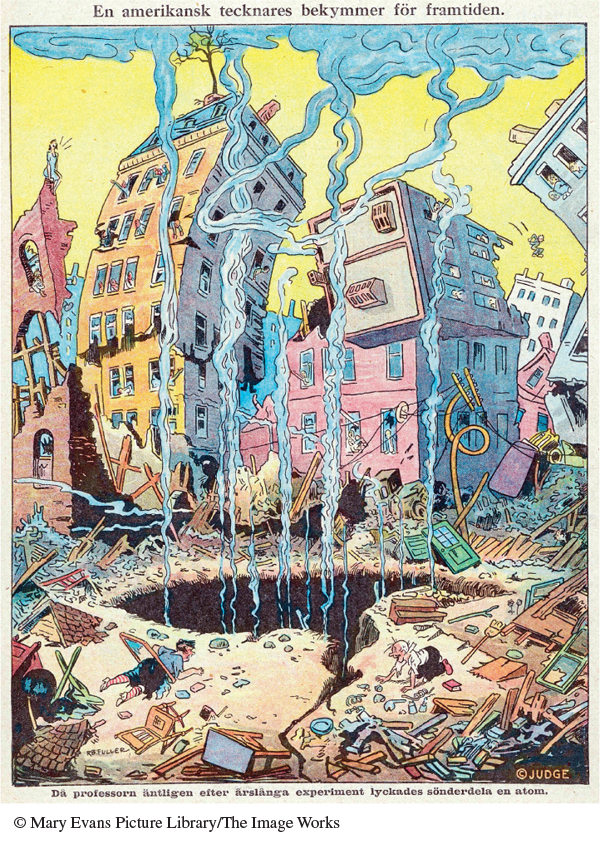A History of Western Society: Printed Page 871
A History of Western Society, Value Edition: Printed Page 837
A History of Western Society, Concise Edition: Printed Page 873
Chapter Chronology
The New Physics
Ever since the Scientific Revolution of the seventeenth century, scientific advances and their implications had greatly influenced the beliefs of thinking people. By the late nineteenth century science was one of the main pillars supporting Western society’s optimistic and rationalistic worldview. Progressive minds believed that science, unlike religion or philosophical speculation, was based on hard facts and controlled experiments. Unchanging natural laws seemed to determine physical processes and permit useful solutions to more and more problems. All this was comforting, especially to people no longer committed to traditional religious beliefs. And all this was challenged by the new physics.
Page 872
An important first step came at the end of the nineteenth century with the discovery that atoms were not like hard, permanent little billiard balls. They were actually composed of many far-smaller, fast-moving particles, such as electrons and protons. Polish-born physicist Marie Curie (1867–1934) and her French husband, Pierre, discovered that radium constantly emits subatomic particles and thus does not have a constant atomic weight. Building on this and other work in radiation, German physicist Max Planck (1858–1947) showed in 1900 that subatomic energy is emitted in uneven little spurts, which Planck called “quanta,” and not in a steady stream, as previously believed. Planck’s discovery called into question the old sharp distinction between matter and energy: the implication was that matter and energy might be different forms of the same thing. The view of atoms as the stable basic building blocks of nature, with a different kind of unbreakable atom for each of the ninety-two chemical elements, was badly shaken.
In 1905 the German-Jewish genius Albert Einstein (1879–1955) went further than the Curies and Planck in undermining Newtonian physics. His theory of special relativity postulated that time and space are relative to the viewpoint of the observer and that only the speed of light is constant for all frames of reference in the universe. In order to make his revolutionary and paradoxical idea somewhat comprehensible to the nonmathematical layperson, Einstein used analogies involving moving trains. For example, if a woman in the middle of a moving car got up and walked forward to the door, she had gone, relative to the train, a half car length. But relative to an observer on the embankment, she had gone farther. To Einstein, this meant that time and distance were not natural universals but depended on the position and motion of the observer.

Unlocking the Power of the Atom Many of the fanciful visions of science fiction came true in the twentieth century, although not exactly as first imagined. This 1927 Swedish reprint of a drawing by American cartoonist Robert Fuller satirizes a pair of professors who have split the atom and unwittingly destroyed their building and neighborhood in the process. In the Second World War, professors indeed harnessed the atom in bombs and decimated faraway cities and foreign civilians.
(© Mary Evans Picture Library/The Image Works)
Page 873
In addition, Einstein’s theory stated that matter and energy are interchangeable and that even a particle of matter contains enormous levels of potential energy. These ideas unified an apparently infinite universe with the incredibly small, fast-moving subatomic world. In comparison, the closed framework of the Newtonian physics developed during the Scientific Revolution, exemplified by Newton’s supposedly immutable laws of motion and mechanics, was quite limited (see Chapter 16).
The 1920s opened the “heroic age of physics,” in the apt words of Ernest Rutherford (1871–1937), one of its leading pioneers. Breakthrough followed breakthrough. In 1919 Rutherford showed that the atom could be split. By 1944 seven subatomic particles had been identified, the most important of which was the neutron. Physicists realized that the neutron’s capacity to shatter the nucleus of another atom could lead to chain reactions of shattered atoms that would release unbelievable force. This discovery was fundamental to the subsequent development of the nuclear bomb.
Although few nonscientists truly understood the revolution in physics, its implications, as presented by newspapers and popular science fiction writers, were disturbing to millions of men and women in the 1920s and 1930s. As unsettling as Einstein’s ideas was a notion popularized by German physicist Werner Heisenberg (VER-nuhr HIGH-zuhn-buhrg) (1901–1976). In 1927 Heisenberg formulated the “uncertainty principle,” which postulates that nature itself is ultimately unknowable and unpredictable. He suggested that the universe lacked any absolute objective reality. Everything was “relative,” that is, dependent on the observer’s frame of reference. Such ideas caught on among ordinary people, who found the unstable, relativistic world described by the new physicists strange and troubling. Instead of Newton’s dependable, rational laws, there seemed to be only tendencies and probabilities in an extraordinarily complex and uncertain universe. Like modern philosophy, physics no longer provided comforting truths about natural laws or optimistic answers about humanity’s place in an understandable world.
